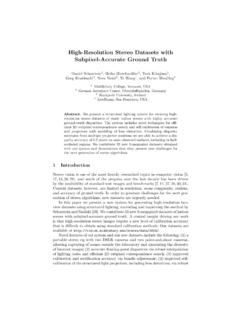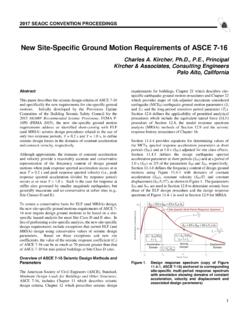Transcription of High-Resolution Stereo Datasets with Subpixel-Accurate ...
1 High-Resolution Stereo Datasets with Subpixel-Accurate ground Truth Daniel Scharstein1 , Heiko Hirschmu ller2 , York Kitajima1 , Greg Krathwohl1 , Nera Nes ic 3 , Xi Wang1 , and Porter Westling4. 1. Middlebury College, Vermont, USA. 2. German Aerospace Center, Oberpfaffenhofen, Germany 3. Reykjavik University, Iceland 4. LiveRamp, San Francisco, USA. Abstract. We present a structured lighting system for creating high- resolution Stereo Datasets of static indoor scenes with highly accurate ground -truth disparities. The system includes novel techniques for effi- cient 2D subpixel correspondence search and self-calibration of cameras and projectors with modeling of lens distortion. Combining disparity estimates from multiple projector positions we are able to achieve a dis- parity accuracy of pixels on most observed surfaces, including in half- occluded regions.
2 We contribute 33 new 6-megapixel Datasets obtained with our system and demonstrate that they present new challenges for the next generation of Stereo algorithms. 1 Introduction Stereo vision is one of the most heavily researched topics in computer vision [5, 17, 18, 20, 28], and much of the progress over the last decade has been driven by the availability of standard test images and benchmarks [7, 14, 27, 28, 30, 31]. Current Datasets , however, are limited in resolution, scene complexity, realism, and accuracy of ground truth. In order to generate challenges for the next gen- eration of Stereo algorithms, new Datasets are urgently needed. In this paper we present a new system for generating High-Resolution two- view Datasets using structured lighting, extending and improving the method by Scharstein and Szeliski [29].
3 We contribute 33 new 6-megapixel Datasets of indoor scenes with Subpixel-Accurate ground truth. A central insight driving our work is that High-Resolution Stereo images require a new level of calibration accuracy that is difficult to obtain using standard calibration methods. Our Datasets are available at Novel features of our system and our new Datasets include the following: (1) a portable Stereo rig with two DSLR cameras and two point-and-shoot cameras, allowing capturing of scenes outside the laboratory and simulating the diversity of Internet images; (2) accurate floating-point disparities via robust interpolation of lighting codes and efficient 2D subpixel correspondence search; (3) improved calibration and rectification accuracy via bundle adjustment; (4) improved self- calibration of the structured light projectors, including lens distortion, via robust 2 Scharstein, Hirschmu ller, Kitajima, Krathwohl, Nes ic , Wang, Westling (a) (b) (c) (d).
4 Fig. 1. Color and shaded renderings of a depth map produced by our system; (a), (b). detail views; (c) resulting surface if disparities are rounded to integers; (d) resulting surface without our novel subpixel and self-calibration components. model selection; and (5) additional imperfect versions of all Datasets exhibit- ing realistic rectification errors with accurate 2D ground -truth disparities. The resulting system is able to produce new Stereo Datasets with significantly higher quality than existing Datasets ; see Figs. 1 and 2 for examples. We contribute our new Datasets to the community with the aim of providing a new challenge for Stereo vision researchers. Each dataset consists of input images taken under multiple exposures and multiple ambient illuminations with and without a mirror sphere present to capture the lighting conditions .
5 We provide each dataset with both perfect and realistic imperfect rectification, with accurate 1D and 2D floating-point disparities, respectively. 2 Related work Recovery of 3D geometry using structured light dates back more than 40 years [3, 4, 25, 32]; see Salvi et al. [26] for a recent survey. Applications range from cultural heritage [21] to interactive 3D modeling [19]. Generally, 3D acquisition employing active or passive methods is a mature field with companies offering turnkey solutions [1, 2]. However, for the goal of producing High-Resolution Stereo Datasets , it is difficult to precisely register 3D models obtained using a separate scanner with the input images. Existing two-view [7] and multiview [30, 31] Stereo Datasets for which the ground truth was obtained with a laser scanner typically suffer from (1) limited ground -truth resolution and coverage; and (2) limited precision of the calibration relating ground -truth model and input images.
6 To High-Resolution Stereo Datasets with Subpixel-Accurate ground Truth 3. Bicycle2 Playroom Pipes Playtable Adirondack Piano Newkuba Hoops Classroom2 Staircase Recycle Djembe Fig. 2. Left views and disparity maps for a subset of our new Datasets , including a restaging of the Tsukuba head and lamp scene [24]. Disparity ranges are between 200 and 800 pixels at a resolution of 6 megapixels. address the second problem Seitz et al. [30] align each submitted model via ICP. with the ground -truth model before the geometry is evaluated, while Geiger et al. [7] recently re-estimated the calibration from the current set of submissions. Establishing ground -truth disparities from the input views directly avoids the calibration problem and can be done via unstructured light [1, 6, 34], but only yields disparities for nonoccluded scene points visible in both input images.
7 Scharstein and Szeliski [29] pioneered the idea of self-calibrating the structured light sources from the initial nonoccluded view disparities, which yields registered illumination disparities in half-occluded regions as well. We extend this idea in this paper and also model projector lens distortion; in addition, we significantly improve the rectification accuracy using the initial correspondences. Gupta and Nayar [10] achieve subpixel precision using a small number of sinusoidal patterns, but require estimating scene albedo, which is sensitive to noise. In contrast, we use a large number of binary patterns under multiple exposures and achieve subpixel precision via robust interpolation. We employ the maximum min-stripe-width Gray codes by Gupta et al. [9] for improved robustness in the presence of interreflections and defocus.
8 Overall, we argue that the approach of [29] is still the best method for ob- taining highly accurate ground truth for Stereo Datasets of static scenes. The contribution of this paper is to push this approach to a new level of accuracy. In addition, by providing Datasets with both perfect and imperfect rectification, we enable studying the effect of rectification errors on Stereo algorithms [13]. In Section 4 we show that such errors can strongly affect the performance of high- resolution Stereo matching, and we hope that our Datasets will inspire novel work on Stereo self-calibration [11]. 4 Scharstein, Hirschmu ller, Kitajima, Krathwohl, Nes ic , Wang, Westling Calibration initial imperfect images calibration calibration Code decoding, 2D view merged 2D bundle 2D matching merging images interpolation disparities disparities adjustment perfect calibration decoding, 1D view merged 1D.
9 Rectification 1D matching merging interpolation disparities disparities self-calibr., 1D illum. Perfect Imperfect merging warping reprojection disparities disparities disparities Ambient Perfect Imperfect rectification rectification images ambients ambients Fig. 3. Diagram of the overall processing pipeline. 3 Processing pipeline The overall workflow of our 3D reconstruction pipeline is illustrated in Fig. 3. The inputs to our system are (1) calibration images of a standard checker- board calibration target; (2) code images taken under structured lighting from different projector positions; and (3) ambient input images taken under differ- ent lighting conditions . The main processing steps (rows 2 4 in Fig. 3) involve the code images taken with the two DSLR cameras. First, the original (unrectified) code images from each projector are thresh- olded, decoded, and interpolated, yielding floating-point coordinates of the pro- jector pixel illuminating the scene.
10 These values are used as unique identifiers to establish correspondences between the two input views, resulting in subpixel- accurate 2D view disparities, which are used in a bundle-adjustment step to refine the initial imperfect calibration. The processing then starts over, taking rectified images as input and producing 1D view disparities (row 3 in the dia- gram). The merged disparities are used to self-calibrate each projector (row 4), from which 1D illumination disparities are derived. All sets of view and illumi- nation disparities are merged into the final perfect disparities, which are then warped into the imperfect rectification. Corresponding sets of ambient images are produced by rectifying with both calibrations (row 5). We next discuss the individual steps of the processing pipeline in detail.






